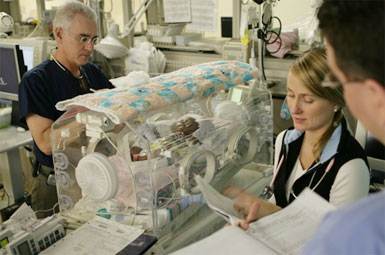Elective surgery patients were anaesthetised with propofol with or without fentanyl and had an oropharyngeal airway placed. They were ventilated with pressure control ventilation via facemask held with a single handed traditional ‘EC clamp’ grip and with a two-handed jaw thrust, and compared. The order in which these two techniques were trialled was randomised. All breaths were delivered with a peak pressure of 15 cm H2O, an inspiratory-to-expiratory ratio of 1:1, at a frequency of 15 breaths per minute. Ventilation was more effective with the two handed technique.
 Using a self-inflating bag for resuscitation, this would translate to a two-person technique. Of note in methodology however was use of a ‘standard pillow’ and some emphasis on head extension. Perhaps ventilation would have been more effective with either technique if they had applied the golden rule of ear-to-sternal-notch positioning: a must for effective mask ventilation and successful laryngoscopy.
Using a self-inflating bag for resuscitation, this would translate to a two-person technique. Of note in methodology however was use of a ‘standard pillow’ and some emphasis on head extension. Perhaps ventilation would have been more effective with either technique if they had applied the golden rule of ear-to-sternal-notch positioning: a must for effective mask ventilation and successful laryngoscopy.
BACKGROUND: Mask ventilation is considered a “basic” skill for airway management. A one-handed “EC-clamp” technique is most often used after induction of anesthesia with a two-handed jaw-thrust technique reserved for difficult cases. Our aim was to directly compare both techniques with the primary outcome of air exchange in the lungs.
METHODS: Forty-two elective surgical patients were mask-ventilated after induction of anesthesia by using a one-handed “EC-clamp” technique and a two-handed jaw-thrust technique during pressure-control ventilation in randomized, crossover fashion. When unresponsive to a jaw thrust, expired tidal volumes were recorded from the expiratory limb of the anesthesia machine each for five consecutive breaths. Inadequate mask ventilation and dead-space ventilation were defined as an average tidal volume less than 4 ml/kg predicted body weight or less than 150 ml/breath, respectively. Differences in minute ventilation and tidal volume between techniques were assessed with the use of a mixed-effects model.
RESULTS: Patients were (mean ± SD) 56 ± 18 yr old with a body mass index of 30 ± 7.1 kg/m. Minute ventilation was 6.32 ± 3.24 l/min with one hand and 7.95 ± 2.70 l/min with two hands. The tidal volume was 6.80 ± 3.10 ml/kg predicted body weight with one hand and 8.60 ± 2.31 ml/kg predicted body weight with two hands. Improvement with two hands was independent of the order used. Inadequate or dead-space ventilation occurred more frequently during use of the one-handed compared with the two-handed technique (14 vs. 5%; P = 0.013).
CONCLUSION: A two-handed jaw-thrust mask technique improves upper airway patency as measured by greater tidal volumes during pressure-controlled ventilation than a one-handed “EC-clamp” technique in the unconscious apneic person.
A Two-handed Jaw-thrust Technique Is Superior to the One-handed “EC-clamp” Technique for Mask Ventilation in the Apneic Unconscious Person
Anesthesiology. 2010 Oct;113(4):873-9






